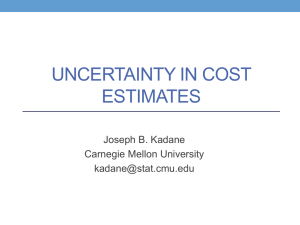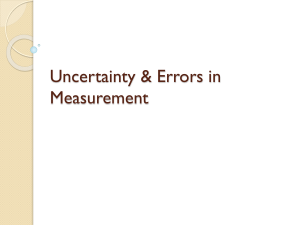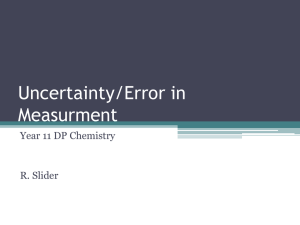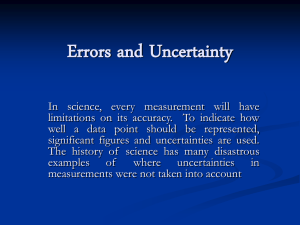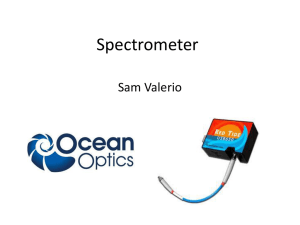NMI TR 2 Uncertainty Analysis for the Derivation of the NML2003
advertisement
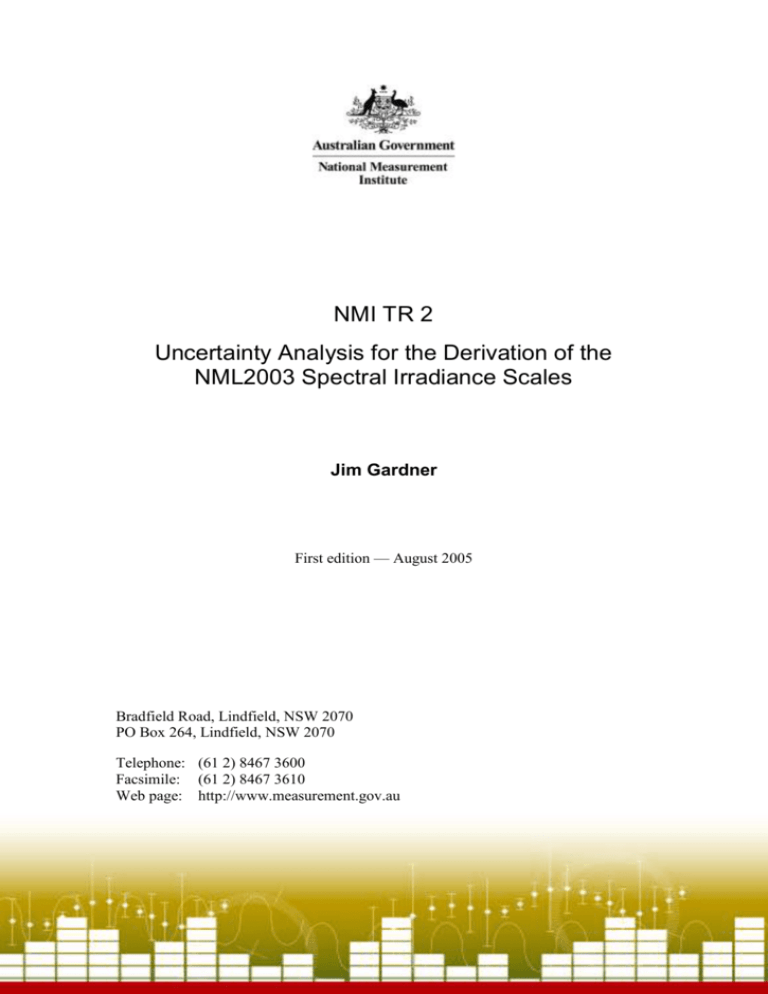
NMI TR 2 Uncertainty Analysis for the Derivation of the NML2003 Spectral Irradiance Scales Jim Gardner First edition — August 2005 Bradfield Road, Lindfield, NSW 2070 PO Box 264, Lindfield, NSW 2070 Telephone: (61 2) 8467 3600 Facsimile: (61 2) 8467 3610 Web page: http://www.measurement.gov.au © Commonwealth of Australia 2005 CONTENTS 1 Introduction ............................................................................................................ 1 2 Propagation of Ratio Uncertainty Components ..................................................... 2 2.1 Measured Signal Ratio ................................................................................. 2 2.2 Ratio Calculated from the Spectral Components ......................................... 2 2.2.1 Offset Components ....................................................................... 4 2.2.2 Scaling Components ..................................................................... 4 2.2.3 Wavelength Components .............................................................. 4 3 Uncertainty Propagation for the Radiometer Measurements ................................. 4 3.1 McPherson Measurement System ................................................................ 4 3.2 Transfer between Lamp and Blackbody ( ) ............................................ 5 3.3 Window Transmittance ................................................................................ 6 3.4 Emissivity .................................................................................................... 6 3.5 Radiometer Responsivity ............................................................................. 7 4 Results .................................................................................................................... 8 iii PREFACE This document propagates uncertainties through the spectral integrals used to establish the temperature of the NMI blackbody and hence the NML scales of spectral irradiance in 2003, rigorously treating the random and systematic components of the measurement. The experimental details involved in the derivation of the scales are described in NMI TR 1. Basis of NML2003 Scale of Relative Spectral Irradiance. The uncertainty analysis in that document has a more complete treatment of the overall uncertainty, but a less rigorous treatment of the uncertainties in the spectral sums used to establish the temperature of the blackbody. Hence the analysis is presented here; the final result then adopts the remaining components from NMI TR 1 and compares the two analyses. iv 1 INTRODUCTION Details of the experimental method and the filter radiometers are given in NMI TR 1. Each filter radiometer signal is S ( ) ( ) ( ) L( , T ) R( ) (1) where ( ) is the ratio of lamp spectral irradiance to the blackbody spectral irradiance (a measured quantity) ( ) is the blackbody window transmittance (a measured quantity) ( ) is the blackbody (BB) spectral emissivity (estimated) L( , T ) is the calculated blackbody radiation at temperature T R( ) is the spectral responsivity of the filter radiometer (a measured quantity) Given the ratio of measured signals S1 and S 2 from two channels, we solve R S1 S2 1 i i i Li (T ) R1,i 2 j j j L j (T ) R2, j F1 (T ) F2 (T ) (2) for the temperature of the blackbody. Subscripts i and j are used to indicate wavelength. Note that the spectral interval may be different for the two channels, although we have assumed that the interval in a given channel is fixed. Now we need to estimate the uncertainty in that temperature. We can use implicit differentiation to solve Eq. (2) for the sensitivity of the temperature directly in terms of each measured or estimated spectral value (responsivity, window transmittance, emissivity, spectral quotients). However, it is much simpler to deal in terms of the spectral ratios. Once we have solved Eq. (2), we numerically calculate the sensitivity coefficient for temperature on that spectral ratio dT R (T T ) R (T ) 1 (3) T dR Alternatively the sensitivity coefficient can be calculated from the two-colour effective wavelength. This sensitivity is different for each chosen pair of filters. Then for each independent component contributing to the temperature uncertainty dT u (T ) u (R ) (4) dR Total uncertainty is then found by adding these independent components in quadrature. The two-colour effective wavelength is given by 1 1 1 e ,1 e,2 where e is the effective wavelength of the respective filter. The temperature uncertainty for a given filter combination is then approximately T 2 u (T ) urel (R ) c2 where c2 = 1.44 107 nm K is Plancks second radiation constant. NMI TR 2 (5) (6) 1 Calculated uncertainties taking the peak centre as the effective wavelength are shown in Table 1 for a temperature of 3000 K and an uncertainty in the spectral ratio of 0.1%. Table 1. Uncertainty in temperature for 0.1% relative uncertainty in signal ratio at 3000 K (bold indicates the filter combinations used) Radiometer e (nm) Combination Λe U(T) #4 340 4,3 1391 0.87 #3 450 3,11 2475 1.55 #11 550 11,6 2567 1.60 #6N 700 3,6N 1260 0.79 #8 940 6N,8 2742 1.71 #1 1300 8,1 3394 2.12 #9 1540 1,9 8342 5.21 6N,1 1283 0.80 8,9 2413 1.51 2 PROPAGATION OF RATIO UNCERTAINTY COMPONENTS 2.1 Measured Signal Ratio The uncertainty in the measured ratio is simply that of the signals after correction for background and any non-linearity in the amplifier. This component is generally small. 2.2 Ratio Calculated from the Spectral Components The uncertainty in the ratio R is first estimated for each of the constituent quantities F1 and F2 ; these uncertainties are then combined into those of the ratio, taking into account the correlation between the numerator and denominator. The correlations are different for systematic and random components: For components random between wavelengths The filter combinations used show little or no overlap between wavelengths. Hence the sum terms in the numerator and denominator of Eq. (2) have no or negligible common components. It follows that for random effects (ie random between wavelengths), the correlation between denominator and numerator is zero, and 2 2 2 urel (R ) urel ( F1 ) urel ( F2 ) (7) For components systematic between wavelengths Uncertainties in linear combinations of correlated components are fully correlated. The correlation can be positive or negative – we need to consider signed uncertainties (in practice only for systematic wavelength effects). From Eq. (2) and the law of propagation of uncertainties, we have 2 2 1 F 1 F1 u (R ) u 2 ( F1 ) 12 u 2 ( F1 ) 2r u ( F1 )u ( F2 ) F2 F22 F2 F2 where r = ±1 is the correlation coefficient between the fully-correlated numerator and denominator. 2 NMI TR 2 (8) 2 Hence urel (R ) urel ( F1 ) rurel ( F2 ) (9) Now we consider the four different measured or estimated spectral terms in Eq. (1). For each taken in turn as pi , we can write F pi qi Li (T ) (10) where qi is the product of the other three terms. In all cases we calculate relative uncertainties in the integrals, using only the central significant range of the spectral responsivity data, for which the wavelength spacing is constant for a given radiometer, and hence have dropped the term. If the spectral quantity for two radiometers are measured independently (in this case it means with different wavelength offsets due to different alignments), they are uncorrelated, and for each quantity in turn, we estimate the uncertainty in the spectral sums F1 and F2 for the two filter radiometers and hence in their ratio for each independent component of pi . The sensitivity coefficient for each pi is dF qi Li (T ) (11) dpi We then estimate us ( pi ) , where the s subscript indicates a signed uncertainty (important for determining the correlation for systematic effects), for each independent component of pi . For each measured quantity, the independent uncertainty components can be generally treated as three types, offsets, scaling and wavelength, each with systematic and random divisions. For random components 2 u 2 ( F ) qi Li (T ) us2 ( pi ) (12) and there is no correlation between the numerator and denominator of the ratio. For systematic components us ( F ) pi qi Li (T )us ( pi ) and the correlation coefficient between two filter signals is r sgn(us ( F1 ))sgn(us ( F1 )) where sgn( ) is the sign function. (13) (14) Note that for uncertainties in the measured lamp-BB ratios, we need the full form of Eq. (1) at the solved BB temperature; for the other components, Eq. (1) reduces to S E ( ) ( ) ( ) R( ) (15) where E ( ) is the spectral irradiance of the lamp, and Eq. (11) becomes dF qi (16) dpi where qi contains Ei in place of i Li (T ) . Lamp FEL4 is taken as representative for the uncertainty calculations here. NMI TR 2 3 2.2.1 Offset Components These are typically constant and able to be expressed as a constant fraction of the maximum signal, although corrected signals may have a variable uncertainty estimated at each wavelength. For these, us ( pi ) is known directly. 2.2.2 Scaling Components Systematic scaling components are not important here if constant, as they affect only the relative value of the signals and hence cancel in the ratio. Of course, any scaling of one filter relative to another, eg due to drift in one and not the other, directly affects the ratio and hence the estimated temperature. Random noise in the relative value will contribute to the overall uncertainty. 2.2.3 Wavelength Components Here dpi u ( ) (17) d dependent on the slope of the measured quantity. This is most important for the radiometer responsivity functions which vary much more rapidly with wavelength than the other terms. Because all radiometers were calibrated at the one time, any wavelength offsets are fully correlated between the radiometers in a pairing. Note also that the radiometer responsivity is measured as a transfer against a reference device, and the slope of the reference responsivity should be accounted for, as shown below, although the dominant effect will be due to the slope of the filter transmittance. us ( pi ) 3 UNCERTAINTY PROPAGATION FOR THE RADIOMETER MEASUREMENTS Now we are in a position to estimate actual uncertainties for the radiometer pairs. In all these estimates, the temperature of the blackbody is taken as an average of the estimated value, 2920 K for measurements below 700 nm, 2830 K above. In each case we avoid correlations introduced through interpolation by interpolating the components other than the one under study to the wavelengths at which the studied component was measured. 3.1 McPherson Measurement System Spectral comparisons with the McPherson monochromator system are made in blocks over a limited wavelength range to reduce effects of drift during the measurement time. Reference and zero measurements are made at the start, middle and end of each block, for both the reference artefact and the test artefact at a reference wavelength where signals for both are strong (generally near the centre of the response band for measurements with the filter radiometers). Each measurement is the mean of up to 50 separate readings. Reported results include the standard deviation of the mean value. Hence we can readily estimate uncertainty components required for propagation through the spectral sums. The relative random uncertainty in each measurement sequence is taken as a typical value for the standard deviation of the mean at the reference wavelength across the measurement blocks, divided by the signal at the reference wavelength. NMI TR 2 4 The random uncertainty of the offset in the measurement is taken as a typical standard deviation of the mean for the measurement zeroes across the measurement blocks. The systematic offset is estimated from a typical range of zero measurements within the measurement blocks. The uncertainty is taken as the half-range divided by √3. For each of these components, the reference and test items are treated separately. Small numbers of repeat runs were averaged – no account is taken of the averaging here. 3.2 Transfer between Lamp and Blackbody ( ) Three different lamp types were used, with different spectral characteristics in the UV region. Lamp FEL4 is taken as representative. The sensitivity coefficient at each wavelength is dF i i Li (T ) Ri (18) dpi We take the measured signals at each wavelength as the irradiance values themselves (this ignores monochromator gain differences) E i i (19) Li (T ) Random noise in the measurements is uncorrelated between measurements and wavelengths; for the component proportional to the signal (eg current noise, gain noise) urel ( i ) urel 2 ( Ei ) 2 urel 2 ( Li (T )) 2 E L (T ) k i i Ei Li (T ) 2 (20) 2k where k is the relative uncertainty in the signals (assumed the same for both sources), and (21) u( i ) iurel ( i ) 2k i Offsets are treated as a fractions k of the signal at some reference wavelength. For the lamp signal, from Eq. (19) u ( Ei ) k1 ER Li (T ) Li (T ) For the blackbody signal, from Eq. (19) E u ( L (T )) k L (T ) i u L ( i ) i i 2 2 R Li (T ) Li (T ) u E ( i ) (22) (23) Random offsets are due to electronic background noise. We separately propagate random offsets in the lamp and blackbody signals, then combine them in quadrature. Systematic offsets are correlated across wavelengths for the blackbody and for the lamp. NMI TR 2 5 Systematic offsets due to scatter are correlated for those radiometers measured in the one setup, ie filters in the visible range and in the infrared range. Hence systematic effects are summed linearly for the lamp and for the blackbody offsets. The total effect due to offsets is then found by adding the lamp and blackbody results for a given filter ratio in quadrature. For wavelength uncertainty in the lamp signal u ( Ei ) k dEi u E ( i ) Li (T ) Li (T ) d and in the blackbody signal u L ( i ) Ei u ( Li (T )) Li (T ) 2 k i dLi (T ) Li (T ) d (24) (25) where k is the uncertainty (in nm where the derivative has units of responsivity per nm). Random wavelength settings are correlated between lamp and blackbody. Systematic wavelength uncertainties are fully correlated across wavelengths for the blackbody and the lamp signals. 3.3 Window Transmittance The sensitivity coefficient at each wavelength is dF i i Li (T ) Ri Ei i Ri (26) dpi For random relative measurement noise u( i ) k i (27) For offsets u( i ) k R (28) where the R subscript denotes the reference wavelength (not so important here as the window transmittance is approximately constant). The window transmittance was measured on the Cary spectrophotometer. Estimates of the peak-to peak variation between adjacent points were used to derive the random uncertainty of the measurement. Data were taken at 10 nm intervals, then interpolated to 2 nm intervals for the calculation of the integrals. Hence the random uncertainty estimate was multiplied by √5 to compensate for the effect of averaging random effects over five times too many points. Uncertainty in a systematic offset in the window transmittance was estimated from steps in the data over a wider range of wavelengths. 3.4 Emissivity Emissivity is treated separately, simply as a change in relative emission of the blackbody at the centre of the radiometer response. This component is covered as an average over the radiometer response range in the original analysis (refer to NMI TR 1) and is not recalculated here. NMI TR 2 6 3.5 Radiometer Responsivity The sensitivity coefficient at each wavelength is dF i i i Li (T ) Ei i i (29) dpi The responsivity is a transfer from that of a reference detector, spectral responsivity RR ,i ; as for the lamp-blackbody transfer, we take the signals to be proportional to the responsivities themselves, and hence Ri ti RR ,i (30) with R (31) ti i RR ,i Uncertainties in spectral responsivity arise through the transfer process and from those of the reference spectral responsivity. For the reference detector (H8W taken in the visible range, TD1 in the IR range) u ( Ri ) ti u ( RR ,i ) (32) The uncertainties are correlated for near-neighbours, ie for wavelengths within the pass-band of the filter radiometers, and we can estimate a constant correlation coefficient and hence contributions from systematic and random components for a given filter. For random relative uncertainties in the transfer u ( Ri ) RR ,i u (ti ) RR ,i kti kRi (33) where k is the relative uncertainty in the transfer. For offsets in the signal channel u( Ri ) RR,iu(ti ) RR,i u( Ri ) kRr RR,i (34) where kRr is the scaled uncertainty in terms of the responsivity at the reference wavelength. For offsets in the reference channel R (35) u( Ri ) RR,i u(ti ) RR ,i i 2 u( RR ,i ) kti RR ,r RR,i Offsets are correlated within the signal channel and within the reference channel, but not between the channels. Wavelength uncertainties in the signal and reference channels are fully correlated. Hence dt u ( Ri ) i RR ,i u ( ) d 1 dRi R dR i 2 R ,i RR ,i u ( ) (36) R d R d R ,i R ,i dR dR i ti R , i u ( ) d d NMI TR 2 7 4 RESULTS The spreadsheet ‘BB uc analysis’ (found in … haea\Sp irradiance project\JG) propagates uncertainties for all the above components. Lamp FEL4 is taken as representative for calculating the blackbody to lamp transfer. Measurements in the visible range assume a blackbody temperature of 2920 K, those in the infrared region assume 2830 K. Two-colour effective wavelengths were calculated for these temperatures. Random wavelength uncertainties are assumed correlated between lamp and blackbody in the BB-lamp transfer at each wavelength, similarly for the reference and radiometer detectors in the responsivity determination. Wavelength offsets are assumed correlated for all the visible measurements, and all the IR measurements, but not for the visible-ir transfer using radiometers R6N and R1. Systematic offsets are assumed uncorrelated between artefacts, but correlated for the one artefact at all wavelengths. Table 2 shows uncertainty values estimated for the measurement data assumed for the various uncertainty components. Offset components for the spectral measurements are relative to the signal strength at the centre of the response band. Table 3 shows the equivalent temperature uncertainties. The spectral change in the sensitivity factors for the various components give rise to quite different uncertainties for the different filters. Table 2. Uncertainty components for each of the filter radiometers (systematic offsets are quoted relative to maximum signal levels) Uncertainty components Responsivity Reference, relative, random Transfer, relative, random Transfer, radiometer, offset, random Transfer, radiometer, offset, systematic Transfer, reference, offset, random Transfer, reference, offset, systematic Wavelength, random Wavelength, systematic Window Relative, random Offset, random Offset, systematic Wavelength, random Wavelength, systematic BB transfer Offset, lamp, random Offset, lamp, systematic Offset, BB, random Offset, BB, systematic Relative, random Wavelength, random Wavelength, systematic NMI TR 2 R3,vis R6N,vis R8,vis R8,ir R1,ir R9,ir 1.00E-03 4.00E-05 1.00E-05 8.66E-05 1.00E-06 4.33E-06 0.03 0.1 1.00E-03 5.00E-05 2.70E-06 2.89E-05 7.00E-07 2.89E-07 0.03 0.1 1.00E-03 9.00E-05 1.30E-05 5.77E-05 1.00E-05 2.89E-07 0.03 0.1 1.00E-03 9.00E-05 1.30E-05 5.77E-05 1.00E-05 2.89E-07 0.03 0.2 1.00E-03 3.90E-05 4.50E-06 2.89E-04 3.30E-06 3.18E-05 0.03 0.2 1.00E-03 3.40E-05 2.80E-05 1.21E-03 2.70E-06 4.33E-06 0.03 0.2 3.47E-04 3.47E-04 3.47E-04 3.47E-04 3.47E-04 3.47E-04 0.001 0.001 0.001 0.001 0.001 0.001 1.34E-04 1.34E-04 1.34E-04 1.34E-04 1.34E-04 1.34E-04 0.03 0.03 0.03 0.03 0.03 0.03 0.1 0.1 0.1 0.2 0.2 0.2 2.00E-06 2.89E-06 2.00E-06 2.89E-06 2.30E-04 0.03 0.1 2.00E-06 2.89E-06 2.00E-06 2.89E-06 2.30E-04 0.03 0.1 1.30E-06 3.58E-04 1.80E-05 5.20E-04 6.00E-05 0.03 0.1 1.30E-06 3.58E-04 1.80E-05 5.20E-04 6.00E-05 0.03 0.2 1.30E-06 3.58E-04 1.80E-05 5.20E-04 6.00E-05 0.03 0.2 1.30E-06 3.58E-04 1.80E-05 5.20E-04 6.00E-05 0.03 0.2 8 Note that the values in Table 3 do not include an allowance for emissivity variations, the integrated radiometer signal measurement uncertainties, drift components or shifts in window transmittance due to contamination. These and similar effects directly affect the filter ratio and are propagated from the sensitivity coefficient calculated from the two-colour effective wavelength. Table 3. Temperature uncertainties (K) for the component values shown in Table 2 Temperature uncertainties R3 R6N R6N R8 R6N R1 R8 R9 Reference, relative, random 0.208 0.410 0.266 0.183 Transfer, relative, random 0.009 0.029 0.012 0.013 Transfer, radiometer, offset, random 0.285 0.002 0.005 0.002 Transfer, radiometer, offset, systematic 0.226 0.119 0.220 1.164 Transfer, reference, offset, random 0.215 0.000 0.003 0.001 Transfer, reference, offset, systematic 0.109 0.003 0.001 0.029 Wavelength, random 0.312 0.506 0.489 0.238 Wavelength, systematic 0.771 0.487 0.313 0.195 Relative, random 0.129 0.238 0.092 0.141 Offset, random 0.488 0.971 0.464 0.405 Offset, systematic 0.142 0.309 0.171 0.151 Wavelength, random 0.000 0.000 0.000 0.000 Wavelength, systematic 0.000 0.003 0.002 0.000 Offset, lamp, random 0.001 0.001 0.001 0.001 Offset, lamp, systematic 0.007 0.350 0.399 0.503 Offset, BB, random 0.002 0.004 0.009 0.009 Offset, BB, systematic 0.005 0.300 0.173 0.234 Relative, random 1.457 3.293 1.822 0.502 Wavelength, random 0.111 0.028 0.016 0.034 Wavelength, systematic 0.893 0.166 0.275 0.072 Totals 1.989 3.591 2.367 1.020 Responsivity Window BB transfer NMI TR 2 9 Table 4. Component uncertainties from NMI TR 1 and total uncertainties in temperature (K) for the various radiometer combinations Other component uncertaintiess R3 R6N R6N R8 R6N R1 R8 R9 Emissivity of blackbody 0.095 0.196 0.128 0.080 Integrated wing response 1.086 0.586 2.496 0.725 Sphere geometric factors 1.267 2.757 2.332 1.351 Temporal drift 0.484 1.054 1.158 0.516 Non-linearity of detector 0.528 1.149 0.576 0.890 Amplifier gain ratio 0.211 0.460 0.254 0.225 Totals, including Table 3 components 2.7 4.8 4.7 2.1 Values from NMI TR 1 1.9 3.4 3.8 3.7 Table 4 shows additional components propagated from the uncertainty values given in NMI TR 1. The final combined uncertainty for each radiometer pair is also shown in Table 4, along with the values estimated by other means in NMI TR 1. The final temperature uncertainties estimated by this more complicated analysis are slightly higher than those in NMI TR 1, except for the infrared radiometer combination. The general conclusion is that the two analyses agree fairly well. Propagation from the temperature uncertainties to those in the NMI spectral irradiance scales are discussed in detail in NMI TR 1. NMI TR 2 10




